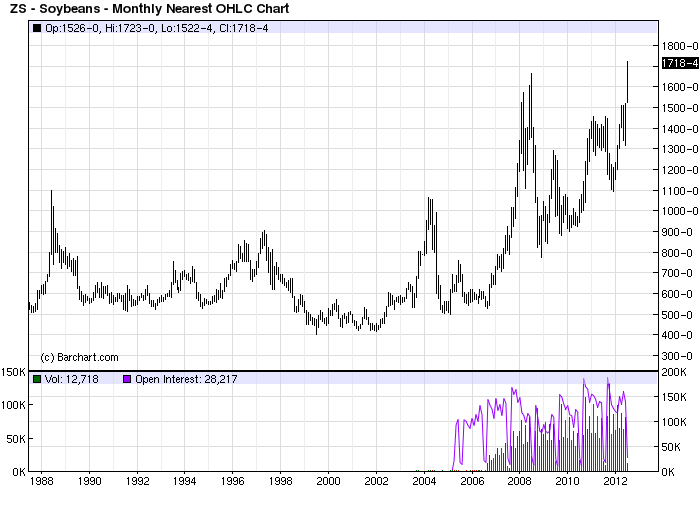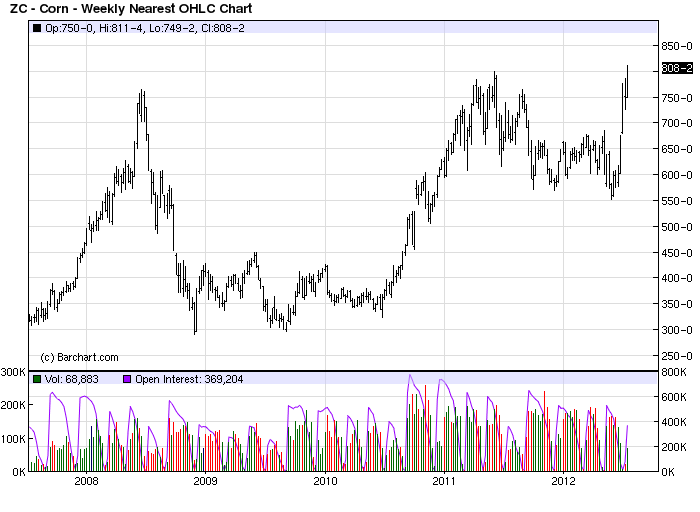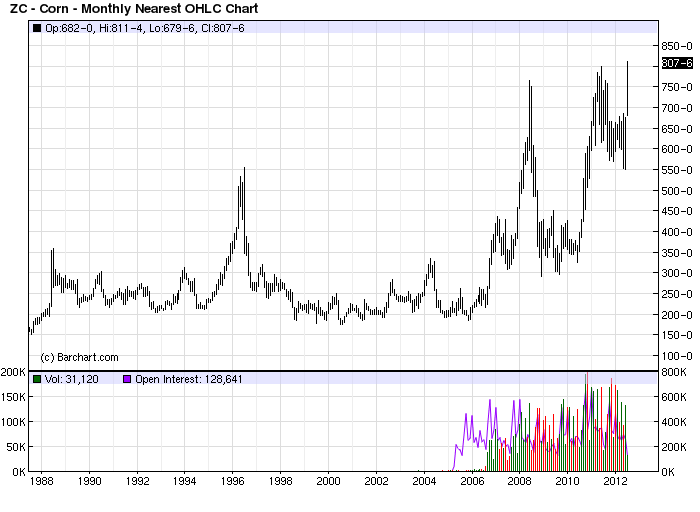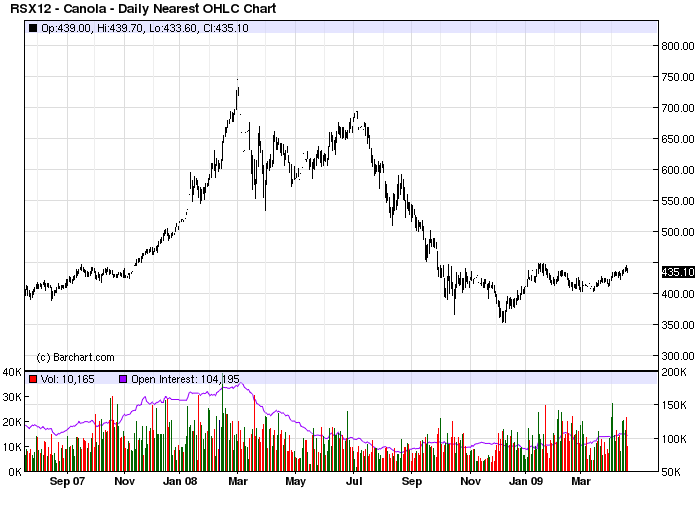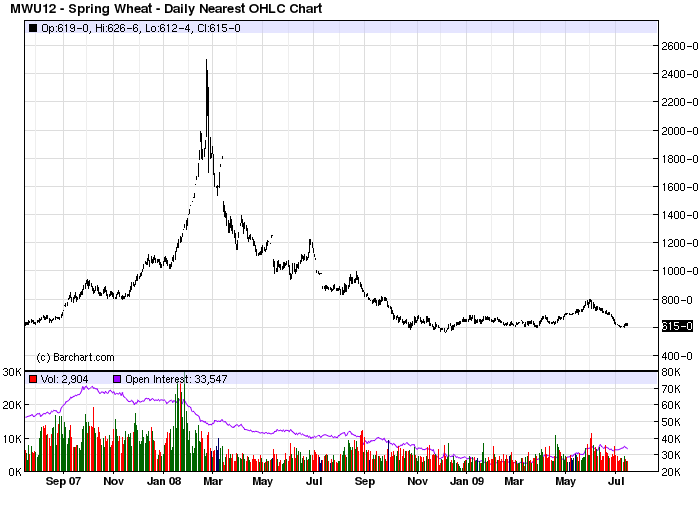Wow! Getting up this morning I immediately checked the prices on the CBOT and there they were: $8 nearby corn and $17.18 soybeans. Big inverses as commercial buyers scramble to buy up the little crop left out there. Incredible prices, setting historical records, lifting all of our boats.Wished I’d stayed up to see these record prices appear overnight, but a guy’s gotta sleep sometime.
Here are some charts to mark this historic time:
We’re certainly in nosebleed territory here. Corn hasn’t convincingly broken out beyond the resistance level that has held since 2008 but soybeans – if they can stay up here for a while – might be smashing through it. And they have the biggest potential, with razor thin stocks-to-use ratios already predicted on yield numbers that no one believes. Where to next? $20 soybeans? Why not? If the U.S. soybean crop is as crappy as some think it is already, and its potential is already significantly reduced, the market really hasn’t yet accepted the critically-low soybean stocks that will exist in a few months, with the South American crop half a year away from being available. (What happens if there’s a problem in South America this winter?)
Read Also

Stacking Canada up on gene editing livestock
Canada may want to gauge how Argentina and other countries have approached gene editing in livestock and what that has meant for local innovation.
That monthly soybean futures chart scares me, because we’ve clearly gone into a parabolic rise and those don’t tend to end well. At some point a stratospheric peak is usually reached, at which it collapses back down most of the way with equal velocity and similar form. Just draw a line underneath the lows on that 25 year soybean chart and you’ll see that curving-up line. But where is the peak? How much higher? These things can blow sky-high, higher than most rational people could ever conceive. When commodity prices break into new territory they can shock everyone, which is a point that commodities guru made to me in 2003 and he’s repeated ever since – especially about agricultural commodity prices. Could this be the year that ag commodities shock everyone – including farmers? Just because we can’t imagine it doesn’t mean it won’t happen.
We have experience with parabolic rises, most recently in 2008. Remember that one? Didn’t last long.
It was more intense (and prettier on the charts) with Hard Red Spring Wheat futures at the Minneapolis Grain Exchange:
There’s a big difference this time, on the fundamental side: there is not a mega-crop in the Midwest US field waiting to come in. (See my following blog post for pix taken yesterday of the situation in the Midwest by our farm production editor Mike Raine. He’s down in the Midwest right now documenting the situation.) Tight stocks-to-use going into 2008 scared everyone and helped drive crop prices high as the general commodity bullishness of the year put terror into buyers and greed into speculators looking for $200 oil and similarly bullishly priced commodities across the spectrum. But a big crop produced everywhere helped quash the bull story for ag commodities, and the worldwide economic meltdown destroyed the value of all assets, including crops. This time there is a real, historically significant drought in the U.S. and there’s no easy way to make up that lack of production. If anything, the markets haven’t yet woken up to the problem today. As Darin Newsom of DTN has repeatedly pointed out, when ag futures prices are sharply inverted it’s a very bullish scenario because the inverse shows that the commercial users are figuring it out and scrambling to fill their nearby needs while there is still some crop out there, but others with a longer term interest aren’t in there yet. Are the short crops factored into prices yet?
It’s hard to see a sudden supply improvement ending this rally. What could do turn things around? I’d say the best bet for something to kill this raging bull market is a global economic meltdown a la 2008, which really isn’t that far-fetched. Europe, the U.S., the BRICS, China, Japan are all stumbling. They could fall and that would kill demand for everything. Nouriel Roubini, one of the predictors of the ’08 meltdown, says there’s a chance of a global “perfect storm” coming this winter, so it’s not unimaginable. (As anyone who listens to my blatherings knows, I’ve been waiting for the second big leg-down in the world markets and economy since 2009. Haven’t been right yet.)
As long as both corn and soybeans are rising and holding at these and higher levels, all our prairie crops are trading at incredible levels, which is great for crop farmers with good crops and terrible for livestock producers. But since crops are a far more important part of the prairie ag industry, in general these are historically wonderful times for us – as long as we can get these crops into the bin.
There could be a huge canola crop coming, if we get cooperative weather, and we need both booming demand and tight stocks to give us the prices that could make this the most profitable year ever for most prairie farmers. The crops out there still have to face the scorching temperatures of late July and August, and all the dangers of bugs and storms bring, but there’s a chance that we’ll get lucky and get the best of all worlds: big crops and big prices.
The scariest time is between now and when the crop comes in. High prices are out there. Many farmers are scared to lock in too much until they know it’s safe. If there’s a parabolic collapse, then this could all be lost. So as I always caution at these times, think about buying some insurance. Check out new crop put options and decide how much you’re willing to pay to protect these prices. It’ll be nice if they keep rising, but since we’re living in historical times, it’s worth learning from history, and history says sudden spikes also often suddenly disappear.


